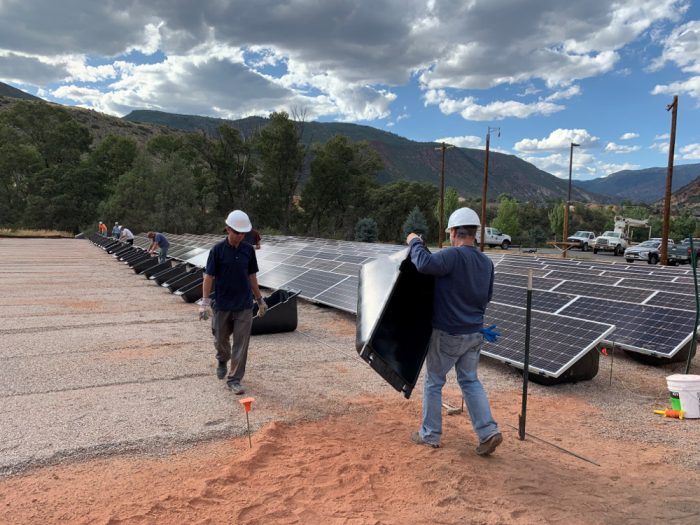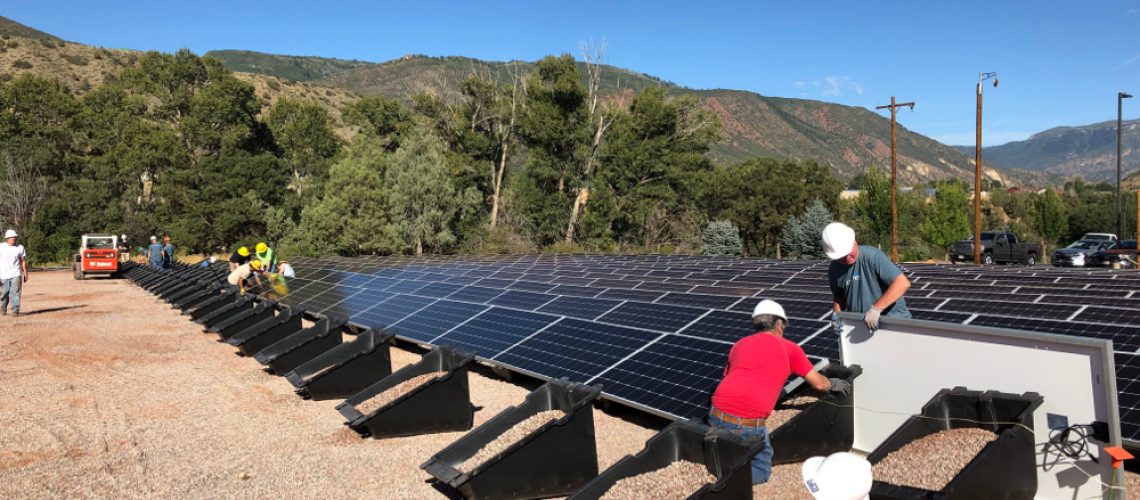Holy Cross Energy (HCE), a rural electric cooperative in Colorado, is deploying a 450 kW community solar project to serve manufactured housing in Eagle County, in the state’s northwestern region.
The project is part of HCE’s Sustainable Solar initiative, which seeks to increase accessibility to renewable energy for low-and-moderate income (LMI) members.
“We recognize there is inequality in the access to renewable energy,” says HCE programs manager Lisa Reed, who presented a webinar on Feb. 23 about the project as part of the Clean Energy States Alliance (CESA) Scaling up Solar for Under-Resourced Communities initiative.
Reed’s webinar, moderated by CESA project manager Matt Ohloff, highlighted HCE’s efforts to develop a solar farm at the Eagle County Regional Airport that will provide up to 3 kW of solar power for each member at no cost to them. Typical home solar installations range between 7 kW and 10 kW.
HCE is targeting 150 members located in manufactured housing parks in the region. The company is currently working on securing the land permits to build the project, which is estimated to be in service by October to help offset costs of 2023-2024 winter heating bills.
CESA is leading an initiative to bring solar to manufactured homes and other underserved communities. The organization’s Scaling up Solar for Under-Resourced Communities project is funded by the U.S. Department of Energy with a mission to solve the challenge of ensuring that solar technologies benefit all Americans regardless of income. In addition to manufactured homes, the project also focuses single-family homes and community institutions.
Manufactured homes, often referred to as mobile homes, comprise more than 6% of the country’s housing stock and represent an even larger share of housing for LMI families, according to a CESA study.
Founded in 1939, HCE is a cooperative corporation with 167 employees and serves more than 43,000 members with 58,000 meters with a peak demand of 250 MW. Its members include major ski resorts in the Aspen and Vail areas as well as farms, ranches and rural communities that provide resources for local residents, tourists and outdoor recreation industries.
The organization has a renewable energy goal of “100×30,” meaning HCE seeks to provide its members with 100% renewable energy by 2030. HCE ended 2022 at 50% and is on target to reach 80% by the end of 2024.
The project is being developed in partnership with Eagle County as part of the Beneficial Electrification of Eagle County Homes (BEECH) program, which provides energy improvements at no cost for income-qualified residents. CESA also is providing financial support.
Site selection
The Eagle County Regional Airport was selected as the project site after a previous location was rejected because of ownership and size concerns, Reed says. The piece of property at the airport turned out to be perfect. The land wasn’t suitable for expansion, and a solar array fits with the airport’s renewable energy goals and federal land lease requirements. Reed also liked that the project will be visible from U.S. Route 6 that passes by the airport.
“This location is tough, but it’s doable,” Reed says. “We’re working with the FAA on a study to acquire federal land use approval for the lease.”
While the deal is not finalized yet, Reed believes the project is a “no brainer” as the airport has three other solar arrays on buildings that don’t impact air traffic and other operations.
System specs
Once approved, HCE is planning a three-day “barn raising” event in September to foster hands-on community involvement in the installation of the solar array. The company is deploying the PowerField Energy PowerRack system, which HCE has used on two other solar arrays in its footprint, a 208 kWdc system built in 2019 at HCE’s Glenwood Springs campus and a 210 kWdc system built in 2022 at its Gypsum campus. The PowerField racking system is designed to be fast and easy to install.

Although details of the project could still change, Reed expects the solar array to sit on approximately 2.5 acres at the airport, including a 10-ft barrier between the array and the fence and allotting for 4 ft between the panel rows.
HCE has partnered with the Colorado Energy Office to identify possible subscribers to the new system among the estimated 1,500 manufactured homes in Eagle County. HCE will be conducting outreach efforts to sign up 150 members.
The project will offer each prospective member about 3 kW for 4,500 kWh with a maximum cap of 5 kW through a format similar to virtual net metering. Reed anticipates a savings of about $500 per year on average for each participant in the program.
Community solar projects like the one HCE is developing are beneficial to Colorado residents, says Stephanie Insinna-Sahondo, director of the Weatherization Assistance Program at the Colorado Energy Office.
“We’re seeing interest from other developers in the state,” Insinna-Sahondo adds. “Community solar is great for renters as well.”
One of the challenges with manufactured homes is that they are often not structurally strong enough for rooftop systems, and residents often don’t have access to enough land for a ground-mount system.
HCE has partnered with the Colorado Energy Office and Eagle County for funding but also has its own resources through its WeCARE program, which includes a 2% monthly charge that was voted on by members to be added to their monthly bills in 2008. The program’s goal is to raise $3 million to fund energy efficiency and conservation measures as well as renewable energy generation.
HCE will also seek the 30% solar investment tax credit (ITC) made available through the 2022 Inflation Reduction Act (IRA).
“Our goal for Sustainable Solar is that we’re gong to make renewable energy a reality for everyone in our community,” Reed says.
Brad Kramer is managing editor of Solar Builder.
Tags: Clean Energy States Alliance, Colorado, Community Solar, Holy Cross Energy, Manufactured Housing, mobile homes, PowerField Energy






